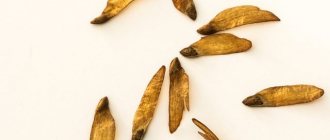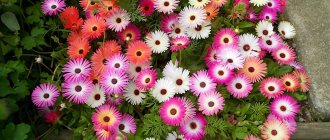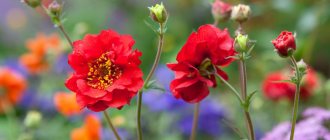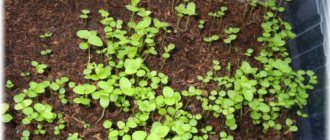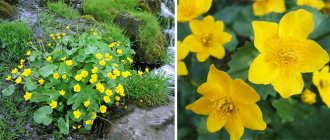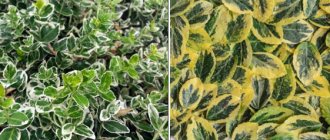Types and varieties of plants, appearance
Spreading cranberries today can be presented on the market in several forms. If you are interested in what cranberries look like, especially those growing wild in the forest, you will encounter plants that are guaranteed to be different from each other. The most common options include:
- Swamp cranberry. Most often, this herbaceous plant is found in the eastern hemisphere. It has bright red berries and a very rich composition, which includes vitamin C and various useful macro- and microelements.
- Lesnaya. Along with marsh, it is also considered one of the most useful. Usually has medium-sized berries of a pale red color.
- Garden or home. A herb that you can easily grow in your own garden. This type of cranberry plant has more attractive blooms. Moreover, unlike the two previous types, each berry is large.
The best varieties
Garden cranberries are represented by several standard species that have long been cultivated - large-fruited and swamp. Based on the standard varieties, many varieties and hybrids have been developed.
Varietal cranberries are more unpretentious and acclimatize more easily in summer cottages
The most popular varieties:
| Varieties | Short description |
| "Ben Lear" | Early ripening form of cranberry. Berries can be picked from graceful branches at the end of summer. If the growing conditions are met, the yield from an area of 1 m2 reaches 2 kg. Large berries are dark burgundy. The shelf life is short - up to two weeks. |
| "Franklin" | A variety with medium ripening periods. The collection takes place in the first half of September. The average yield is 1.5 kg/m2. Sour red berries are stored without freezing or processing without loss of quality for up to 4 months. |
| "Stevens" | A highly productive representative of the crop that produces ripened berries only in mid-autumn. The formation of dense skin in fruits is associated with late periods of fruiting. Thanks to the latter, the crop can be stored in a cool, dark room for up to 1 year. |
Where and how does it grow
If you are interested in how cranberries grow and looking at bright photos of cranberries, you should know that this is a Holarctic plant species common in the northern hemisphere. Most often the plant can be found in North America and Eurasia. The natural habitat is considered to be the eastern part of the USA and Canada. As for natural locations, you can find the plant in swamps and wet or coniferous areas.
Reproduction methods
You can grow cranberries using two methods - generative (seed) and vegetative. In the first case, it will not be possible to preserve varietal characteristics. This method is only suitable for standard species.
Cuttings
When intensive growth of shoots occurs, planting material is harvested. Cut cuttings about 10 cm long. First prepare a substrate that will meet the required parameters. They take high-moor peat, sand, and rotted pine needles. Fill the container with soil mixture. You can root the cuttings immediately in a permanent place, adhering to the 7 x 7 cm pattern. With this arrangement, the shoots of the bush will quickly close together.
Benefit
The beneficial properties of cranberries are quite difficult to describe, since there are so many of them. All thanks to the rich composition of the berry, which is saturated with macro- and microelements, as well as substances such as:
- acids, including citric, malic, quinic, benzic;
- vitamins;
- glucose, sucrose and fructose.
All this together nourishes our body and positively affects all its important aspects of life.
Properties of cranberries
Cranberry is a berry containing many useful microelements and vitamins. The composition of this berry helps protect the intestines from infections and improves stomach function.
With regular consumption of cranberries, you can prevent the development of varicose veins and normalize blood pressure.
They are prescribed by doctors for vitamin deficiency, rheumatism and ARVI. Cranberry juice helps heal burns and coughs, and also reduces temperature during fever.
However, in addition to the beneficial properties, there are also contraindications for consuming cranberries. It should not be used for diseases of the gastrointestinal tract (ulcers, gastritis, high acidity of the stomach).
Also, people with unhealthy livers should treat this berry with great caution. And dentists warn that cranberry is not recommended for weakened tooth enamel.
Grapes - history, description, care features, varieties and diseases + 80 photos
- Stinging nettle - medicinal properties, effects and applications + 74 photos
Wheat - varieties, places to grow and beneficial properties + 78 photos
Application
When you type the query “cranberry photo berry” into a search engine, be sure to take a look at how you can use the berry in everyday life. Next we will describe several variations of the use of cranberries in everyday life.
In cooking
In this case, delicious red berries are most often added to salads, sauces, baked goods and various additives. The taste of the berry is extraordinary, and allows you to experiment with a wide variety of flavor combinations.
In medicine
As practice shows, the cost of cranberries on the market is very high. This fact is partly explained by the fact that berries have quite a serious effect on our body. Regular consumption of berries guarantees:
- significant reduction in cholesterol levels;
- preventing the formation of blood clots;
- strengthening the walls of blood vessels;
- increased performance;
- neutralization of inflammatory processes;
- prevention of the formation of atherosclerotic plaques.
In cosmetology
Red berries can often be found in well-known cosmetic preparations. A large number of minerals in the berry help rejuvenate the skin, increase elasticity and fight the first signs of aging.
Care
Cranberries are 90% water, and this plant loves moisture. However, despite its “swampy” homeland, you should not allow it to stagnate water in the soil. The soil must be kept constantly moist, because... When the cranberry dries out it quickly dies. It is also advisable to place the garden bed near a pond to create high humidity.
Cranberries winter well in the conditions of Ukraine and have such strong immunity to any diseases and pests that they guarantee us an environmentally friendly harvest. And cranberries are planted once and for life, since this berry lives for at least 100 years and does not require replanting or rejuvenation. Only every 3 years, the bed is generously mulched with fresh peat or sand over the entire carpet, 2-3 cm high.
And if you had told me five years ago that this “northern berry” would grow at my dacha, I definitely would not have believed it. But today my “cranberry carpet” has been giving me 2-3 buckets of healthy berries for two years in a row, which I am endlessly happy about, especially during evening tea parties in winter. Source: © GreenMarket
How to grow, care and pests and diseases
Cranberries are considered a frost-resistant and unpretentious plant, which, unfortunately, is quite difficult to grow at home. All due to the need to provide an appropriate microclimate. At the planting site, the groundwater level must be significantly increased.
For garden varieties of the plant, the presence of groundwater at a depth of 40-45 cm would be ideal. Swamp varieties are best planted in places where groundwater is at a depth of 30-35 cm. You should also take into account the fact that the area for cranberries should be sunny , but at the same time well protected from the wind.
Features of plant propagation - cuttings or seeds?
Another undoubted advantage of cranberry is that it takes root easily, and at the same time, it takes excellent cuttings.
To carry out cuttings, it is necessary to separate the cuttings and plant them in moist soil, previously mulched with sand. To maintain the level of humidity, the bed must be covered with film and do not forget to water. Rooting will take about three weeks, after which side shoots will appear.
But the use of seeds is recommended only when you want to grow cranberries not for fruit, but for decorating your summer cottage. When sowing seeds, the properties of the variety are quite often lost, and the first harvest will appear only after six years, and only with too careful, careful care.
Cranberry seeds are not the best solution for planting if you want to get a harvest of berries.
Note. To ensure seed germination, it is recommended to keep them in the refrigerator for about three months at a constant temperature of +3 degrees. However, even such preparation will not guarantee successful seed germination.
Therefore, if you do not have enough time for careful care, and you are not ready to wait several years for a possible harvest, do not plant cranberries using seeds. It is better to buy seedlings or use cuttings.
About the benefits and uses of cranberries
If everything is done correctly, then in the summer you will be able to collect the first, although not yet abundant, but still your harvest of still small, sour, but already very healthy berries. Cranberry is a real home pharmacy in the garden! In addition to vitamins A, B and C, it simply contains a lot of glucose-fructose, sorbitol, iodine and potassium salts. Listing the acids in this berry alone can tire any pharmacist. In cooking, cranberries are widely used in their natural form; syrups, jams, marmalade, juice, and fruit drinks are made from the berries. A real delicacy is berries in powdered sugar. Cranberries are added when sauerkraut is sauerkraut and used as a seasoning for dietary dishes. Cranberry increases the strength of blood vessels, promotes the absorption of vitamin C in the body, binds and neutralizes heavy metal compounds. Juice with honey helps with colds with high fever, sore throat, rheumatism, anemia.
Caring for cranberries throughout the season
This culture is unpretentious. It is easy to care for: you just need to water, feed and trim it on time.
Caring for cranberries in spring
Basic principles of spring care:
- when the bush is covered with leaves, pruning should be done to prevent thickening;
- the soil in the tree trunk circle should always be moist;
- You should regularly loosen the soil and remove weeds;
- in early spring, fertilize with complex mineral fertilizers (it is important not to overdo it, since the plant cannot easily tolerate an excess of minerals).
Caring for cranberries in the spring consists of loosening, removing weeds and watering.
It is recommended to plant honey-bearing crops such as oregano or savory next to the cranberries - this will attract bees for pollination.
Caring for cranberries in summer
Throughout the summer, it is necessary to monitor the soil moisture; it should not dry out. The plant loves an acidic environment, so when watering it is recommended to add citric acid or vinegar to the water. You should regularly remove weeds and loosen the soil.
If the bush develops normally, fertilizing is not needed, but if the plants are weakened, it is worth applying complex mineral fertilizers. To prevent planting, they are treated with fungicides: Topsin M, Delan, Skor.
Caring for cranberries in autumn
Harvesting is carried out in September and October, and the berries are fully ripened during storage. The bush is treated against pests with insecticides: Calypso, Fozalon, Actellik.
Before wintering, it is necessary to moisten the planting well, cover it with spunbond or spruce branches, and then add a good layer of snow.
Processing cranberries throughout the season
High soil moisture, which the berry loves so much, poses a threat of fungal diseases. To protect, shrubs are treated with fungicides several times a season:
- in the spring, when the buds swell and bloom, it is necessary to treat the plants with Azophos;
- during the budding period, weekly triple treatment with Horus and Skor;
- in November after harvesting - spraying with 1% Bordeaux mixture.
Watering cranberries
It is necessary to water the bush regularly. The soil should be slightly moist, but not wet. Excess liquid can negatively affect the quality of the berries. In hot, dry weather, water should be watered daily with cold water.
Cranberries love moisture, so you can use constant drip watering
Cranberry diseases with description
If you follow the rules of agricultural technology, garden cranberries are distinguished by excellent “health,” but they can still get sick. It is important to detect the disease on time, and for this you need to know the characteristic signs that it manifests itself.
Monilial burn
This is a fungal disease that affects the tops of young shoots: they wither, then turn brown and dry out. In rainy weather they become covered with a coating of fungal conidia. When buds appear on garden cranberries, the damage spreads to them, then to the flowers and ovary. As a result, the flowers dry out and the fruits continue to grow, but rot. Control measures are spraying with copper oxychloride or fungicides Ronilan, Topsin M, Bayleton, Ditan.
Cranberry terry
This is a dangerous viral disease caused by mycoplasma microorganisms. The shoots on the affected plants grow greatly, they stop bearing fruit, and those fruits that set before the development of the disease turn out to be deformed and small. There is no cure for this virus, so diseased plants must be uprooted and burned.
Ascochyta blight
With this disease, dark brown round spots appear on the leaves and shoots of cranberries, and the tissue underneath them begins to crack over time. Treatment – treatment with copper oxychloride, Fundazol, Topsin M.
Pestalocy
This disease affects the shoots, leaves and fruits of garden cranberries. At first, dark brown spots form on them, then they become gray with dark edges, and over time they gradually merge with each other. The shoots bend in a zigzag shape and the leaves fall off. The drug for treatment is copper oxychloride.
Gibber spot
With this disease, premature massive leaf loss occurs, which greatly weakens the bushes. Signs of spotting - in early August, red-brown small spots appear on the leaves, then they become shapeless, chlorotic with a dark rim, in the center of which you can see the fruiting bodies of the fungus. Drugs for treatment - copper oxychloride, Fundazol, Topsin M.
Cytosporosis
This is black rot that appears on berries. Control measures are preventive spraying in spring and autumn with copper preparations and fungicides Topsin M, Fundazol.
Snow mold
This disease develops in early spring. The buds and leaves of the cranberries become red-brown, and yellowish mycelium of the fungus appears on them. By the end of spring, the leaves turn ashy and fall off. If there is no treatment, the plant may die. Control measures include autumn spraying with a solution of Fundazol and freezing the soil during the winter cold.
Phomopsis
This is a disease in which the ends of cranberry shoots dry out without previous wilting. The leaves first turn yellow, then orange or bronze. Dirty gray spots appear on the shoots, which then turn into ulcers, flowers and berries turn brown. Prevention measures - early spring treatment with copper preparations.
Botrytis
This is a gray fluffy rot that appears on the shoots, green leaves and flowers of plants on humid days. Treatment is medications containing copper.
Red spot
A fungal disease that causes cranberry shoots to become deformed and die. Buds, flowers and their stalks become pinkish. The leaves emerging from the affected buds resemble small roses. Treatment is copper-containing preparations or fungicides.



